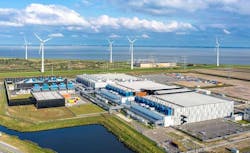How green are your cloud services? Google is now providing granular data about the carbon impact of customer applications running in Google Cloud.
Google says the new Carbon Footprint feature in its Cloud Console will provide customers with one-click access to emissions data for carbon tracking and disclosure for corporate ESG (Environmental Social, Governance) reporting.
“Fostering sustainability at scale is a key component of our mission,” said Jenn Bennett, Technical Director, Google Cloud Office of the CTO. “Sustainability is now top of mind for every board and CEO.”
The new carbon reporting provides Google with a lead over rival cloud platforms from Amazon Web Services and Microsoft Azure in sustainability reporting, an increasingly important priority for enterprise users amid visible changes in our climate and weather. Google was the first cloud service to matched 100% of its electricity use with renewable energy, and is also leading with climate impact reporting.
Although sustainability is rarely the primary factor driving the choice of cloud providers, ESG is moving up the priority list. Carbon Footprint positions Google as a destination for cloud customers that prioritize their environmental impact.
More Tools for Cloud Climate Compliance
The Carbon Footprint tool is one of a series of climate-focused announcements at its Next 21 conference, which began today. That included new tools to help customers design the greenest app configurations, and shut down idle cloud applications that are using energy.
These services build on years of work by the Google data center team to create a “carbon intelligent” global infrastructure in which sustainability is tracked for every workload across every facility in every location and time zone. Key milestones include:
- In 2017 Google matched 100 percent of its data center consumption and Google enterprise consumption with renewable energy.
- In 2019 it committed to match (data center operations) hour for hour, 24 hours by seven days a week, with renewable energy by 2030.
- In 2020 Google began rescheduling workloads that are not time-sensitive so it can match them to solar power during the day, and wind energy in the evening.
- Earlier this year Google said it can move workloads between data centers to boost its use of renewable power, shifting the data processing for YouTube videos and Google photos to locations where green power is plentiful.
This multi-year effort has laid the groundwork for today’s announcement, equipping Google to assess the carbon impact of customer applications wherever and whenever they are running, and package those findings for easy review and download.
Track Carbon by Time, Project or Region
The new carbon reporting tools were developed in collaboration with customers like Atos, Etsy, HSBC, L’Oréal, Salesforce and Twitter.
“Our Carbon Footprint reporting introduces a new standard of transparency to support you in meeting your climate goals,” said Google Cloud Sustainability lead Chris Talbott and Google Earth product manager Joel Conkling in a blog post announcing the service. “You can monitor your cloud emissions over time, by project, by product and by region, giving IT teams and developers metrics that can help them reduce their carbon footprint. Our detailed calculation methodology is published so that auditors and reporting teams can verify that their cloud emissions data meets GHG Protocol guidance.”
To help customers account for emissions beyond their Google Cloud installations, Google is partnering with Salesforce Sustainability Cloud, which allows users to measure and manage their Scope 1, 2 and 3 carbon emissions.
“As we face unprecedented climate challenges, companies across the globe need to embed sustainability into the core of their business in order to meet growing customer and stakeholder expectations, and reduce their environmental impact,” said Ari Alexander, GM of Salesforce Sustainability Cloud. “Together, Google Cloud and Salesforce Sustainability Cloud can help our joint customers accelerate customers’ path to Net Zero, leveraging data-driven insights and visualizations to track and reduce their carbon emissions to drive sustainable change.”
Choose the Greenest Region, Turn Off Unused Resources
Google recently launched low-carbon region icons within their console to help customers choose cleaner regions for cloud resources. Google says that new users who see the icons are 50% more likely to choose clean regions over others, ensuring their applications emit less carbon over time.
Google also has added sustainability impact information to its Active Assist Recommender, which helps user optimize their cloud configurations. With the Unattended Project Recommender API, users can now discover potential savings by removing idle resources. The new service uses machine learning to identify projects that are likely abandoned based on API and networking activity, billing, usage of cloud services, and other signals. By deleting these projects, users can reduce costs, mitigate security risks, and reduce their carbon emissions.
Google says that Active Assist analyzed the aggregate data from all customers across its platform in August, and over 600,000 kgCo2e was associated with projects that it recommended for cleanup or reclamation. If customers deleted these projects they would significantly reduce future emissions.






